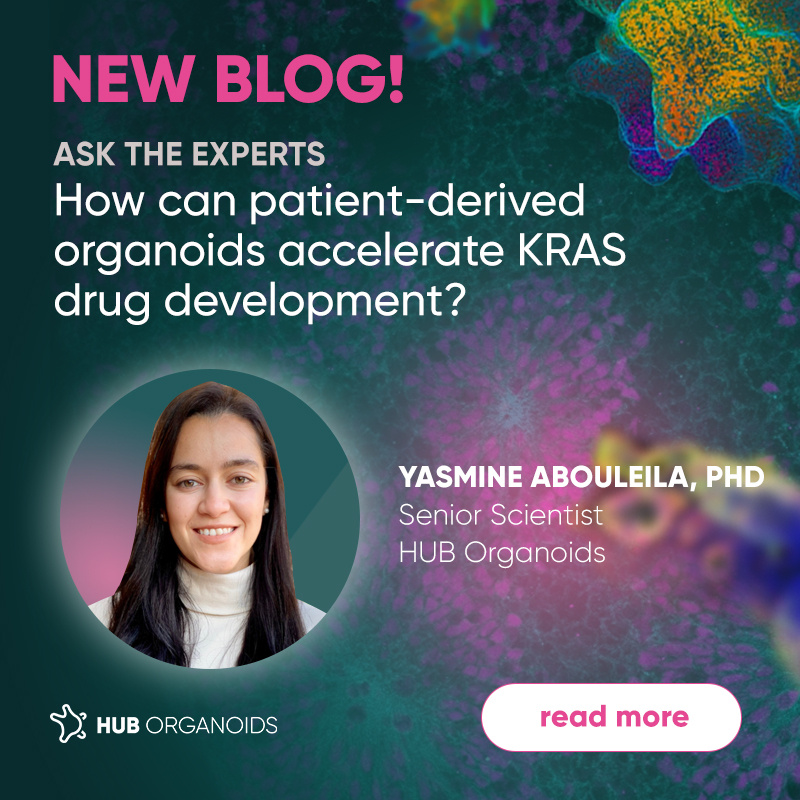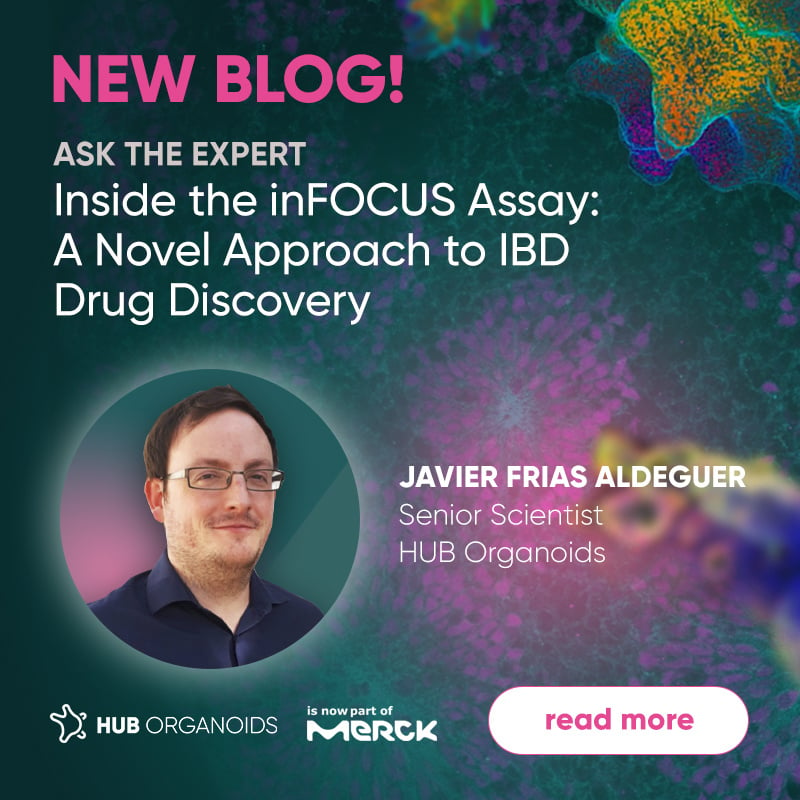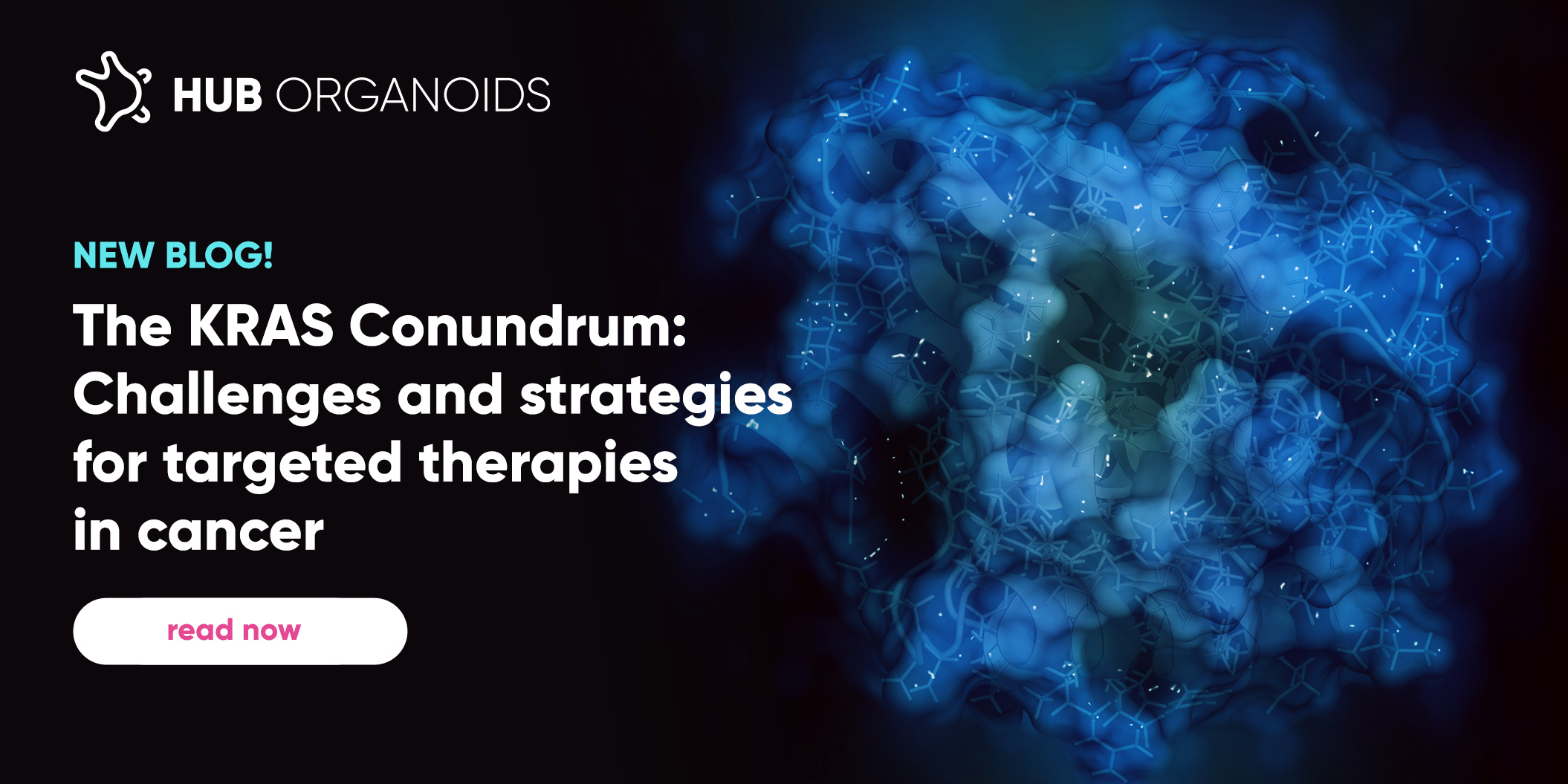Ask the Expert: How can patient-derived organoids accelerate KRAS drug development?
Published by HUB Organoids on Jul 5, 2024

In this edition of Ask the Expert, featuring Dr. Yasmine Abouleila, we explore the transformative potential of organoids in advancing KRAS drug development. Discover how patient-derived organoids (PDOs) are revolutionizing cancer research by faithfully replicating in vivo tumor conditions, facilitating the identification of novel therapies targeting KRAS mutations, and understanding resistance mechanisms.
Why are RAS proteins considered undruggable?
Expert: RAS proteins have been considered undruggable for several reasons. First, they have a very smooth surface without well-defined binding pockets, making it difficult for small molecule inhibitors to bind tightly and precisely. Additionally, mutant RAS proteins exhibit an extremely high affinity for GTP, which makes it challenging to disrupt this interaction and inhibit their constitutive activation. Another complicating factor is the flexibility of RAS proteins, as they can adopt multiple conformations. This flexibility makes it difficult to design inhibitors that can effectively bind and inhibit the protein across its different states. Moreover, RAS proteins are localized to the inner surface of the plasma membrane, which can limit the accessibility of potential inhibitors and pose additional challenges for drug delivery. The lack of structural information on the different mutant forms of RAS hindered rational drug design efforts for a long time. However, recent breakthroughs in understanding the structural dynamics of RAS proteins, particularly the KRAS G12C mutant, have enabled the development of covalent inhibitors that specifically target this oncogenic form. Despite these advances, other RAS mutants remain challenging targets, and overcoming the "undruggable" nature of RAS is still an active area of research in cancer drug discovery.
For the longest time, 2D cancer cell lines have been used for KRAS drug discovery. What are the limitations of these models?
Expert: Cancer 2D cell lines have several key limitations when it comes to developing drugs for KRAS-driven cancers. One major limitation is the lack of tumor heterogeneity. These cell lines are relatively homogeneous and do not capture the diversity of cell types and mutations present in primary tumors. This homogeneity limits their ability to fully represent the complexity of KRAS-driven cancers, potentially leading to less accurate predictions of how a drug will perform in a real tumor setting.
Genetic drift is also a concern with long-term in vitro culture of cancer cell lines. Over time, these cells can undergo genetic and epigenetic changes, altering their characteristics and potentially their response to KRAS-targeted therapies. These changes mean that the cell lines no longer accurately reflect the original tumor from which they were derived, reducing their predictive power for drug efficacy.
Furthermore, there is the issue of limited representation. Most cancer types are represented by only a few 2D cell lines, such as the 6-7 lines typically found in the NCI panel. This limited number of lines may not capture the full spectrum of KRAS mutations and co-occurring alterations found in patient populations. As a result, these cell lines may not adequately represent the diversity of responses seen in different subgroups of patients, making it harder to detect subgroup-specific responses to new KRAS-targeted therapies.
How do patient-derived organoids (PDOs) contribute to the development of cancer therapies, particularly in the context of KRAS mutations; what has been their role in drug development and repurposing?
Expert: Patient-derived organoids (PDOs) are invaluable in developing KRAS therapies because they closely mimic the genetic features of in vivo tumors and can recapitulate patient-specific drug sensitivities. This makes them highly suitable for incorporating patient relevance early in the preclinical development, which can help bridge the gap between preclinical findings and clinical outcomes. In drug development, PDOs offer scalability advantages over patient-derived xenograft (PDX) models, enabling high-throughput preclinical drug screenings. Additionally, HUB Organoid technology allows us to culture normal organoids from the same patients, providing a unique advantage for our clients to test on-target off-tumor toxicities within the same patient context. Furthermore, our research has shown that drug screens on PDO platforms can uncover hidden vulnerabilities within therapy-resistant phenotypes, paving the way for more effective cancer treatments. By leveraging these capabilities, PDOs play a crucial role in both developing new cancer therapies and repurposing existing drugs.
Are PDOs amenable to genetic engineering?
Expert: Yes, patient-derived organoids (PDOs) are compatible with genetic engineering, particularly using CRISPR/Cas9 technology. This compatibility makes PDOs a powerful tool for creating isogenic organoid lines that differ solely in their KRAS mutational status, allowing for precise dissection of KRAS-specific effects while controlling for genetic variability. Additionally, PDOs can be utilized in high-throughput synthetic lethality screens. Our organoid platform has demonstrated significant success in these screens, enabling our clients to identify promising hits from screening large libraries of up to 10,000 compounds. Beyond hit identification, we also assist our clients in discovering mechanisms of action and optimizing leads, providing comprehensive support throughout the preclinical pipeline.
How does the process look like for starting a project with HUB Organoids?
Expert: Our research liaisons and product experts are available to discuss your specific needs for your KRAS project. During this consultation, we provide expert guidance on selecting the most appropriate assays and models to align with your research hypothesis.
If you're considering an efficacy screen, we currently offer an ongoing screen specifically focused on KRAS mutations. You'll have the option to choose from up to 27 well-characterized PDOs, representing a diverse range of KRAS mutations sourced from primary and metastatic tumors in colorectal, non-small cell lung, and pancreatic cancer. Additionally, we provide normal organoids derived from the same patients for off-tumor toxicity assessment.
Our efficacy screen includes an image-based viability assessment of tumor organoid responses, offering precise insights into your compound's effectiveness. Notably, our panel features a tri-organoid model derived from primary tumors, metastatic lesions, and organoids with acquired resistance to Adagrasib. This unique model setup presents an intriguing opportunity for drug developers to investigate resistance mechanisms within a single patient context.
How large is your organoid biobank?
Expert: Our oncological biobank has more than 30 models with KRAS mutations, representing different types of solid cancers. We also have PDOs spanning several disease indications like inflammatory bowel disease, and even rare genetic diseases like cystic fibrosis, across all epithelial organs. Additionally, we have immuno-oncology-specific collections, including a dozen models from which we have isolated tumor-infiltrating lymphocytes (TILs) or cancer-associated fibroblasts (CAFs). Importantly, our biobank is not limited to these examples, as we continually expand our collection to support diverse research needs.
How do PDOs reflect key clinical aspects of drug sensitivity and patient response to treatments?
Expert: PDOs accurately reflect critical clinical aspects of drug sensitivity and capture heterogeneity in treatment response. For instance, in our recent publication on colorectal cancer (CRC) organoids, we’ve noticed that PDOs from patients with left-sided colon RAS/BRAF-wildtype tumors are most sensitive to panitumumab, mirroring findings from large clinical trials. Additionally, PDOs captured increased resistance after prior 5-FU treatment, representing the 5-FU resistant state seen in clinical practice. These observations suggest that PDOs can model the effects of prior chemotherapy on subsequent treatment responses, making them valuable for studying resistance mechanisms and evasion strategies in CRC.
How do pre-clinical drug screens using therapy-resistant PDOs differ from traditional drug screens, and what potential do they hold for cancer treatment development?
Expert: Pre-clinical drug screens using therapy-resistant PDOs differ from traditional drug screens in that they specifically focus on identifying drugs that can exploit vulnerabilities induced by existing therapies. This approach reflects clinical scenarios where tumors are often treated with multiple drugs, and resistance mechanisms arise. By using PDOs that have already been exposed to specific treatments, these screens can uncover secondary vulnerabilities that are not apparent in untreated models. This method holds great potential for developing new treatment combinations that are more effective against therapy-resistant cancers, paving the way for innovative and personalized cancer treatment regimens.
How can organoids be utilized to uncover mechanisms of resistance in KRAS-driven cancers?
Expert: PDOs particularly those from KRAS-driven cancers, provide a physiologically relevant platform for studying resistance mechanisms. Unlike traditional cell lines, PDOs closely mimic in vivo conditions, enabling researchers to explore the stepwise progression toward drug tolerance and acquired resistance. They offer flexibility for genetic modifications, facilitating the development of models resistant to classic KRAS G12C inhibitors. Utilizing CRISPR/CAS9 technology, researchers can introduce secondary KRAS mutations to analyze growth rates and resistance profiles. . PDOs demonstrate genetic stability over time and are ideal for longitudinal studies. By exposing PDOs to treatments and observing their responses, including the development of drug-tolerant persister (DTP) states, researchers can identify genetic changes and pathways involved in evading standard therapies. For more details, you can review our AACR 2024 poster available for download.
What does the future hold for KRAS drug screening in cancer research?
The future of KRAS drug screening appears promising with recent advancements. Emerging technologies such as Organoid Technology offer more patient-relevant models to study KRAS-driven cancers. These models reflect the genetic and phenotypic diversity of tumors, enhancing the identification of effective therapies. Furthermore, novel KRAS inhibitors targeting specific mutations like KRASG12C show encouraging preclinical and early clinical results, potentially transforming treatment options for KRAS-mutant cancers. As these approaches continue to evolve, they hold great potential to improve outcomes for patients with KRAS-driven malignancies.


